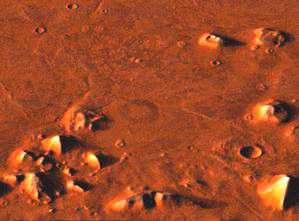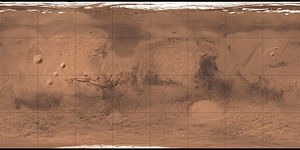Cydonia Mensae
| Highlands on Mars | ||
|---|---|---|
| Cydonia Mensae | ||

|
||
| Relief of the Cydonia region; above the "face of Mars", below the "pyramids" | ||
|
|
||
| position | 37 ° N , 13 ° W | |
| expansion | 854 km | |
Cydonia Mensae ( Latin ; ' Cydonia- Mesa ') is a highland in the northern hemisphere of the planet Mars . It lies between the regions of Acidalia Planitia and Arabia Terra . The center is located at latitude 33 ° 42 'northand longitude 13 ° 00' east, and its greatest extension is 854 kilometers. Cydonia is a poetic name for the Greek island of Crete .
The geological structure of the Cydonia region is complex; its origins have not yet been fully clarified. It consists largely of flat terrain with a low to medium density of impact craters , from which rocky formations rise in places .
It is believed that Acidalia Planitia was an extensive expanse of water billions of years ago and Cydonia Mensae their southeastern coastal region . Back in 2005 could ESA - space probe Mars Express large deposits of water ice on the southern polar caps prove. In 2008, NASA's Phoenix space probe finally detected the occurrence of water ice a few centimeters below the surface.
Mars face


On July 25, 1976, the orbiter of the Viking I space probe photographed a formation at least three million years old from an altitude of 1,873 km that is reminiscent of a human face. It represents an elevation with a length of 3 kilometers and a width of 1.5 kilometers. To the south of it rise pyramidal rocks.
Six days later, the recordings, along with other images, were presented to the public and made headlines. The anomaly was given the name "Face on Mars" by the press due to its shape. The pyramid-like structures were given the name "Inca City" by NASA scientists, although the Incas did not build any pyramids - like the Maya , for example .
Higher-resolution images from the Mars Global Surveyor probe from 2001 showed, however, that the supposed face is a heavily weathered, almost mirror-symmetrical rock formation that was eroded by natural processes ; the resemblance to a human face was most likely due to the interplay of light and shadow at the time of the picture as well as the tendency of humans to prefer to perceive familiar shapes ( pareidolia ). The shapes of the “pyramids” may also have been created by wind erosion.
Cydonia in fiction
Due to the high level of public awareness and numerous, in some cases still ongoing speculations, the Cydonia region and the face of Mars Cydonia appear in science fiction series and films as well as computer games.
- In the computer game Zak McKracken , Cydonia is the location of an abandoned alien base.
- The final battle of the PC game UFO: Enemy Unknown (German mission name Cydonia or death ) was fought in an active alien base in the region of Cydonia, which was the starting point for the alien threat in this game.
- A Mars face also appears in the film Mission to Mars .
- In the sci-fi series Futurama , Cydonia, the face of Mars, is the entrance to the underworld where the Martians live. The exit, the “butt of Mars”, is on the other side of the planet.
- In episode 13 of the sci-fi series Invader Zim , Battle of the Planets , Mars (and Mercury) was converted into a spacecraft by its former inhabitants. The control unit is hidden in the face of Mars.
- At the beginning of the episode Obsessed (Ep. 9, Season 1) of the sci-fi series The X-Files - The FBI's Scary Cases , the photography of the rock formation is briefly discussed. In addition, the former astronaut Lt. Col. Marcus Aurelius Belt plagued by nightmares, including the face of Mars.
- Two songs by the chiptune musician Dubmood , Cydonian Sky and Sleepless (Cydonian Sky # 2) , which are included on the EP Chipdisk Vol.4 , refer to Cydonia.
- The song Knights of Cydonia by the British rock band Muse was created through the belief in Matthew Bellamy (singer and songwriter) in supernatural and oversized forces that should reside there.
- In the pentalogy The Mars Project by Andreas Eschbach is located in the Cydonia region, the station of the aliens (Falaner).
- In the episode The Science Fair - The Return of the Phineas and Ferb series , the Martians Candace build a monument in the shape of their face on the surface of Mars. However, this is destroyed by a laser, so that the real face of Mars is created.
- In the PSP game Final Fantasy 4 Complete Collection, the face is shown on the red moon, where the bonus dungeons can be found.
See also
- Bile (Mars crater) ; contains another "face of Mars" in the form of a smiley face
- Moon face
literature
- Walter Hain : Das Marsgesicht , Herbig-Verlag, Munich and Wels 1995
- Richard C. Hoagland : The Mars Connection. Monuments on the Edge of Eternity , Bettendorf-Verlag, 1994, ISBN 978-3-88498-076-7
Web links
- Cydonia Mensae in the Gazetteer of Planetary Nomenclature of the IAU (WGPSN) / USGS (English)
- Cydonia on Google Mars (English)
- Mars face on Google Mars
- Science @ NASA: Unmasking the Face on Mars (English)
- NASA / NSSDC: Mars Global Surveyor images of the Cydonia Region of Mars (English)
- High resolution color images of the Cydonia region and the face of Mars captured by Mars Express
- Animation ( Adobe Flash )
- DLR: 3-D animation of the so-called Mars face in the Cydonia region October 23, 2006
- DLR : The Cydonia region - the alleged face on Mars September 21, 2006
- DLR: The Cydonia region: Was the north of Mars once covered by a sea? March 12, 2015
Video
- What is it about the face of Mars? from the alpha-Centauri television series(approx. 15 minutes). First broadcast on Oct 25, 1998.
Individual evidence
- ^ Water ice on Martian north crater. In: Web Portal of the European Space Agency (ESA). ESA, July 28, 2005, accessed August 3, 2013 .
- ↑ Thorsten Dambeck: Mars probe: Phoenix discovers ice on Mars. In: Spiegel Online . Spiegel Online GmbH, June 20, 2008, accessed on August 3, 2013 .
